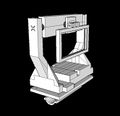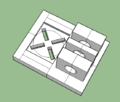Searching for Stability
Contents
Proposal
Project Description
Overview
Our project is to create a bike-mounted stabilizing platform for iPhone cinematography. We will use the readings from two magnetic encoders to control two motors responsible for stabilizing the platform. Vibration dampening pads in the mounting device itself will provide additional stability. If successful, applications of an inexpensive, compact stabilizing device could be innumerable, from handheld usage to RC and aerial filming and photography.
The mounting device of the gimbal is an original design drafted in SketchUp and produced in AutoCAD.
By the end of the semester we will be able to present iPhone footage from our device to illustrate its stabilizing capabilities.
Team Members
- Natalie Ng
- Nathan Schmetter
- Deko Ricketts (TA)
Objectives
- Program an Arduino module to receive data from magnetic rotary encoders to consistently level the iPhone while in use
- Design and construct a practical and functional mounting device for an iPhone on a bike
- Design and embed the gimbal and additional stability elements either onto or within the mounting platform itself
- Successfully stabilize the iPhone while recording a video from a moving bike
Challenges
- Perfecting the programming of the Arduino module in order to analyze the input from the two magnetic rotary encoders and communicate with the two brushless motors to re-level the iPhone
- Ensuring that input from the encoders is readable to the Arduino
- Identifying appropriate motors to carry out the stabilization of the platform
- Designing the mounting device and modifying gimbal design using 3D printer
- Finding the most effective dampening cushions considering size and weight of platform
- Compacting all elements of the design to create an unobtrusive stabilizing device
Budget
Arduino
- Parts Ordered Online
- Hardware
- 4 9V batteries ($21.99)
- 4 Screws to secure dampening pads
- 3 9V Battery Snap Connectors
- Wire
Total: $90.99
Gantt Chart
Design & Solutions
Modules
Motor Circuit
We began our journey with 3-phase induction motors knowing little else than that they were the best possible motors for generating smooth corrections such as those executed by a gimbal.
1. Direct connection: Our first motor circuit was simple, consisting of the three-phase motor and three wires that fed directly into the Arduino with our laptop as the only power source. Somehow, we managed to make this work without frying anything... Using this circuit we managed to not only get extremely reliable motor control, but also responsive communication between our encoders and our motors. The only catch was that our motors lacked torque.
===>
+
The initial circuit. Example of encoder-to-motor control. Paddle rotation with initial circuit.
2. Motor Control Circuit I: After bringing our torque dilemma to Humberto's attention, he told us that there was no way our circuit should have been working, as the Arduino was not providing anywhere near the current or voltage we thought it was due to current-limiting. He suggested a completely new motor control circuit including 6 MOSFET transistors as the answer to our torque problems. Despite being warned to watch our connections as we would now be dealing with large amounts of power, we promptly fried our Arduino. Following Professor Gonzalez's roughly drawn schematic, we built the new circuit and again, managed to get a response from our motors, this time using batteries as an external power supply. For the first time, we were able to generate enough torque to spin our phone.
===>
Motor control circuit with motor. First time spinning the phone.
3. Motor Control Circuit II: Though we thought we had been successful, our batteries began to die as the circuit rapidly discharged them. We realized we would need a power supply for the demo, and this is where everything became massively unreliable. Using a power supply, we would get motor control at times and minutes later the motor would be unresponsive to the same code with the same power supply settings. Additionally, a couple of our transistors were getting dangerously hot. Deko suggested that we buy 6 10 ohm, 10 watt resistors in order to get more power to our motors and to prevent our transistors from heating up. While this improvement helped with the heat issue, our reliability issues persisted.
===>
+
Motor control circuit with Phone rotation. Paddle rotation. updated resistors
How-To: MOSFET Transistor and Diode Checks
3D Design and Printing
When you compare our first design of the stabilization platform/gimbal to our last, many of the differences are blatant. However, in between these designs were many small steps and changes that each addressed a specific issue discovered after analyzing the print of the previous prototype.
- Design 1 was simply a starting point, (Figure 9). It lacked both balance and a mounting bracket for the phone case and was never printed. This iteration helped us realize that we needed a place to attach the vibration dampening pads that would smooth out the video.
- Our second design included space for the vibration dampening pads as well as a place to mount the phone. We realized that mounting the phone with such a high center of gravity would be detrimental to the stability of the platform, (Figure 10).
- Design 3 was the first model we printed, (Figure 11). We quickly realized we needed to re-think clearances because when we rotated the paddle and the phone at the same time, the phone ran into one of the upright supports. This was the first time we were able to assemble the entire prototype, including the motors and the phone. We learned that both the paddle and the phone mount were unbalanced and thus the motors could not produce enough torque to rotate them.
- The balancing process took place before printing our fourth and final prototype and is described in more depth below, (Figure 12) . After balancing, both the paddle and the phone could turn freely within the upright supports. Additionally, we added housing for the encoder that stabilized the base while allowing free rotation of the rotary shaft.
On balancing: Balancing the phone was relatively easy. We modified the original phone mount and elongated it so that, when mounted, the phone's center of gravity lined up directly with its axis of rotation, (Figure 13). Balancing the paddle proved much more difficult as we had to take into account not only the center of gravity of the paddle, but also the contributions made by the center motor, the phone mount, and the phone itself. Our original paddle practically fell over and our motor had no hope of rotating it, (Figure 15). While aiming for the same center of gravity alignment achieved with the phone mount, we overcompensated on our second paddle design, which simply fell the other way, (Figure 16). Our final paddle struck a compromise and even gave us some flexibility, allowing us to load varying amounts of weight on the backside to achieve perfect balance, (Figure 17).
A simple test we used to determine if a component was balanced or not was to see if it retained its position after being rotated to any angle.
How-To: Eliminate Internal Edges and Faces in 3D Files
Coding
Our first task was writing an interrupt that would constantly pull the position of the encoder. This would enable us to know immediately if the encoder moved away from its base position and in which direction, thus allowing us to send a signal to the motor and correct for the position change. We found code online for an interrupt that converted the encoder output to integer references from 0, either positive or negative based on which way the rotary encoder turned. By roughly keeping track of a position on the outer radius of the encoder while we rotated it, we figured out that the encoder went through 78 "ticks" in each rotation.
Writing code for the motor proved to be much more complicated, though it didn't seem so at first, and we went through a number of iterations.
- Our first attempt at motor control consisted of implementing three arrays, one for each of the three phases of the motor, (Figure 19). We wrote to the three pins using a digital output signal, indicating when each phase needed to be activated (HIGH) and when it needed to be off (LOW). This code allowed us to establish smooth rotation of the motor and to control for how long the motor turned, as seen in figures 2, 3, and 5.
- Controlling the length of motor rotation involved determining how many iterations of the array were required for a single rotation. We determined that 42 position iterations was the magic number for a complete rotation.
- Because there were six positions in the array, we wrote code that took the input variable (the number of positions the motor was to rotate) and checked how many times it was divisible by 6. This corresponded to how many times the full array would be looped through. The code then checked for a remainder and instigated a second for-loop to iterate through the remaining positions (5 or less). The last position of the array was then saved in a variable so that the motor would pick up in the phase that it left off, eliminating any bouncing or jittering.
- Once we had changed our motor control circuit to the six MOSFET, six high wattage resistor circuit and were still getting unreliable motor control, Humberto told us that we needed to change our code in order to account for three variables and to generate a PWM output as opposed to a digital output. The three variables were: (1) motor frequency, (2) PWM frequency, and (3) duty cycle.
- This code allowed us to fiddle with both PWM frequency and motor frequency, and in doing so, control duty cycle.
//How-to: Writing Interrupts on Arduino//












